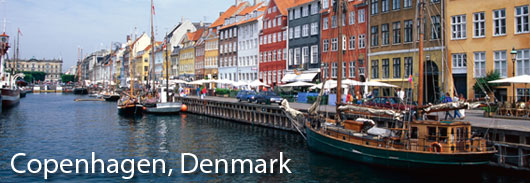
Like Mighty Mouse, Denmark may be small but it packs a powerful punch. Its capital, Copenhagen, seems to be the seat of everything Danish -- artistic, financial, and political. The city continues to change. Middle Eastern restaurants now compete with old-fashioned eateries serving food that Grandmother Denmark used to cook. Internet cafes have become the rendezvous point of choice for young Danes instead of the traditional sudsy taverns beloved by their parents.
But some things never change. Many Copenhageners still bike to work along the city's canals, following their noses to the cafes where the smell of freshly baked bread lures people in for a morning Danish and a cup of freshly brewed coffee.
Copenhagen, the capital of Denmark, got its name from the word køben-havn, which means "merchants' harbor." It grew in size and importance because of its position on the Øresund (the Sound), the body of water between Denmark and Sweden, guarding the strategic passage of all maritime traffic heading into or out of the Baltic.
From its humble beginnings, Copenhagen has become the largest city in Scandinavia, home to 1.8 million people, the seat of one of the oldest kingdoms in the world.
Over the centuries Copenhagen has suffered more than its share of invasions and disasters. In the 17th century, the Swedes repeatedly besieged it, and in the 18th century, it endured the plague and two devastating fires. The British attacked twice during the Napoleonic wars in the early 1800s. In 1940, the Nazis invaded Denmark and held onto Copenhagen until 1945, when the British army moved in again, this time as liberators.
Copenhagen is a city with much charm, as reflected in its canals, narrow streets, and old houses. Its most famous resident was Hans Christian Andersen, whose memory lives on. Another of Copenhagen's world-renowned inhabitants was Søren Kierkegaard, who used to take long morning strolls in the city, planning his next addition to the collection of essays that eventually earned him the title "father of existentialism."
In 2000, the Øresund Bridge was officially opened, physically linking Sweden and Denmark for the first time. Today there's a 15km (9 1/3-mile) car and train link between Zealand (the eastern part of Denmark, the island on which Copenhagen sits) and Skane (the southern part of Sweden). If you'd like to link a visit with Copenhagen to Malmö, Copenhagen's fast-growing counterpart across the border in Sweden, or perhaps visit some of the châteaux of southern Sweden, just drive across the bridge.
Copenhagen still retains some of the characteristics of a village. It's almost as if the city were designed for strolling, as reflected by its Strøget, the longest and oldest pedestrians-only street in Europe.